Many print-savings campaigns founder when exhortations to be green collide with users’ work. It’s one thing to ask people to bring their own mugs to the kitchen, switch to electric hand-dryers, and shut off the lights when they leave. It’s quite another to ask them to cut back on business-critical printing. "We can't print slide decks for everyone who attends sales meetings?," someone will gasp. "What if the prospective gets confused? We're supposed to lose the sale to save a couple of nickels?
Fortunately, print-savings campaigns don’t have to conflict with your core business. There are five big ways that organizations waste money on printing, all of which can be cut without printing a single page less. They are:
#1: Replacing cartridges too early.
The guy or gal who leaves the paper tray empty and quietly tiptoes away is not a popular figure. (Neither is the one who leaves you to wrestle a new jug into the water cooler, or, for that matter, neglects to flush.) But what about the user who walks away from the printer with the “LOW TONER” light illuminated? He or she might be saving your firm a whole bunch of money.
A not-quite-secret: many printers turn on their low-toner warning long before the cartridge is actually empty. The manufacturers are not trying to trick you into wasting toner: they want to give you fair warning to order a new cartridge. But it is important to replace the cartridge only when it is genuinely exhausted.
Printers without cartridges (those that accept bottles or sticks of ink) avoid this problem entirely.
Virebo estimates that for every 100 printers, a typical organization might waste about $180 a month on early supply replacements.
#2: Sending black-and-white jobs to color printers.
Color printers tend to cost considerably more on a per-page basis than black-and-white printers. Color printers are mechanically more complex, so the cost of wear-and-tear per-page is higher. Some (but fortunately not all) color printers also consume color supplies even when they run a pure black-and-white job. While no color toner is emitted, some printers track cartridge lifetime in impressions. The printer increments the impression counter for every page that passes through the cartridge, even if it produces no output. On these printers, it’s possible to exhaust a color cartridge that was never used once. If a job doesn’t have to be in color, run it on a black-and-white printer.
Virebo estimates that a typical organization could save over $200 for every hundred printers every month by not sending black-and-white jobs to color devices.
#3: Sending big jobs to the wrong printers.
As a general rule, the smaller the printer, the higher the cost per page. Larger printers tend to have lower cost-per-impression supplies, more reliable parts, and might even accept toner in less-expensive sticks or bottles, rather than expensive, mechanically complex cartridges.
Replacing an entire print cartridge, including the printhead for an inkjet or a drum assembly for a laser printer, does ensure that the printhead or drum is in tip-top shape, but it can be wasteful if the cartridge is still in good condition. Imagine if you had to replace your wipers every time you refilled your windshield-washer fluid.
A comprehensive program of buying low-cost-per-page printers, moving jobs to existing low-cost-per-page printers, and retiring high-cost printers can produce substantial savings. Virebo’s potential-savings estimates for shifting printing from inefficient printers to the most-efficient printers are close to $800 per 100 printers per month.
#4: Retaining unused printers.

On one 2,500-printer network we studied, Virebo found over 150 printers that produced less than one page per month. In other words, they were bascially unused. But they still consumed electricity, network addresses, and physical space. In total, they used over 1,700 kWh of electricity per month unnecessarily. While modern printers are generally power-efficient when idle, older ones are less so.
There is an easy way to cut never-used printers’ energy use: find and unplug them.
#5: Printing single-sided.
Double-sided printing can cut your paper use in half. Most modern workgroup printers either come with duplexers as standard equipment or can be ordered with one. In most cases, printer drivers can be configured to print double-sided as the default, saving paper. Virebo estimates that a 100-printer organization with typical usage patterns (40% double-sided) could save nearly $250 a month by printing 90% of impressions on double-sided pages.
If you sum over all categories, Virebo estimates that a typical firm might waste nearly $1,300 a month per 100 printers. If you want to cut waste at your firm, Virebo’s Waste Dashboard tracks all of areas described above and shows exactly where to find the waste in each category. You can see a demo at our online demonstration site.
For more information about Virebo, please visit Virebo.com.



